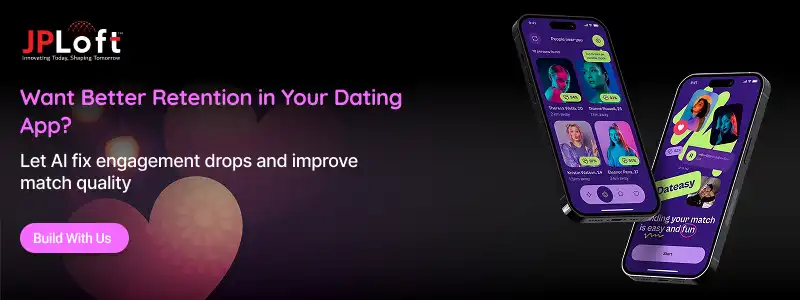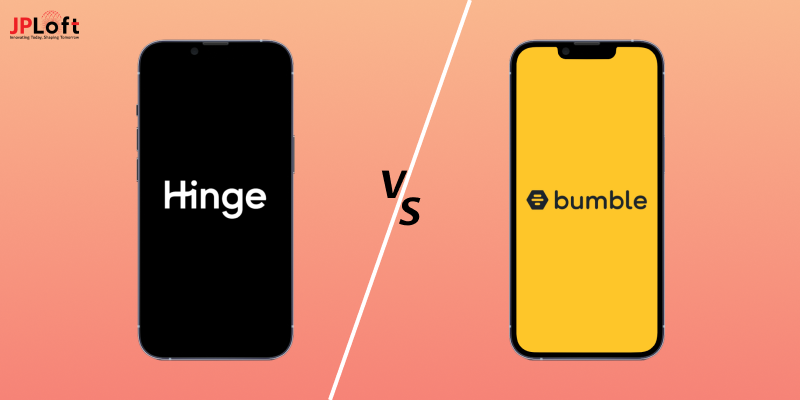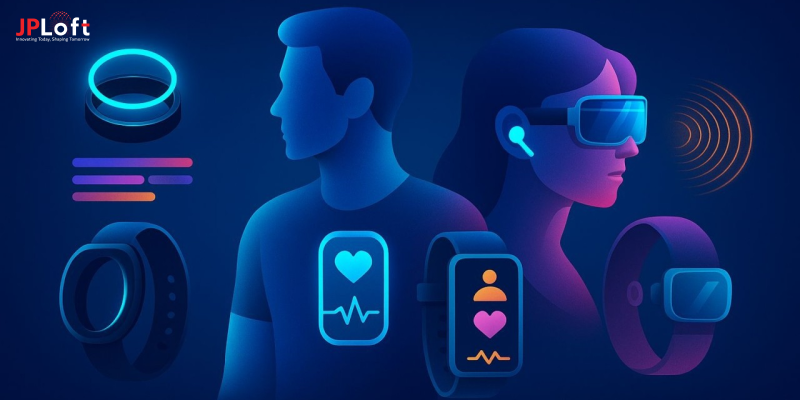Key Takeaways :
Most dating apps lose users early because match quality, engagement flow, and emotional momentum drop within the first few sessions.
Strong retention begins with personalized onboarding, better first-match experiences, and meaningful early interactions that build user confidence.
AI improves retention by predicting behavior patterns, lifting match accuracy, detecting ghosting, and supporting smoother conversations.
Safety features like verification and real-time fraud detection increase trust, which directly boosts long-term user loyalty.
Smart product design, notifications, chat tools, prompts, and guided UX help reduce churn and make each interaction feel rewarding.
JPLoft helps founders build high-retention dating apps through smarter UX, AI-driven personalization, and behavior-led product strategy.
Dating apps attract millions of new users every month, yet most of them disappear long before they form meaningful connections. That’s the core problem- why dating apps struggle with user retention even when downloads look impressive.
Users come in excited, swipe for some days, lose steam, and ultimately wander off to yet another app that promises something better.
The cycle continues because of losses in match quality, quick fade in conversation, and a lack of anticipation with any early wins to keep them to stay.
Dating apps quickly lose users when match relevance, safety signals, and early engagement fall short.
This is where the product design and AI come into play.
When an app can personalize the interaction, provide an accurate match, predict user behavior, and enhance conversation, then the experience will naturally become smoother and far more rewarding to the user.
This is the distinction between an app that users use once, and one that they consistently come back to daily.
Dating App Retention Market Stats
Dating app market stats reveal a tough truth: most users leave long before forming real connections. The numbers show how hard it is to keep people engaged after the first few swipes.
-
The global dating app industry generated over US $6 billion in revenue and is projected to grow to US $8.9 billion by the end of the decade.
-
In the report, it was noted that Day 1 retention for many dating apps is around 24%, Day 7 retention falls to around 11%, and Day 30 retention may be around 5%.
-
Average session length increased from 12.95 minutes in 2023 to 13.21 minutes.
-
Cost per install (CPI) rose from US $1.37 in 2023 to US $1.46, while click-through rate (CTR) improved from 1.7% to 2.2% in the same period.
-
The average retention rate for dating apps sits around 3.3% in 2024, showing how quickly users drop off after the first week.
-
Across all mobile apps, 25–30% of users return on Day 1, but the number falls sharply afterward.
-
The global online dating services market is estimated at US $5.64 billion in 2025, with forecasts showing an 8% CAGR through 2034.
-
By Day 30, dating apps retain only 2% of Android users and about 2.7% of iOS users in 2025.
Let’s be honest here: These numbers reveal impressive market growth, but they also highlight a deeper issue: Most dating apps still struggle to keep users engaged.
And that leads us to a real challenge.
Why Retention Is Hard In Dating Apps?
Dating app retention issues often come from a mix of emotional expectations, inconsistent match quality, and interfaces that don’t create enough early wins.
Let’s get to know the proper reasons as to why retention is hard in online dating apps:
1. Early Engagement Drops Fast
Most users open a dating app with high curiosity, but momentum fades once swipes feel repetitive or matches don’t spark meaningful conversations.
This is why users leave dating apps within days.
The real challenge is how to increase dating app engagement by creating early moments that feel personal and rewarding, not random or algorithmic.
2. Low Match Quality Creates Frustration
When users get irrelevant or low-compatibility matches, they quickly assume the app “doesn’t work for them.”
Better scoring, smarter recommendations, and contextual prompts matter more than visual polish.
Strong dating app product design focuses on expectations, helping users feel understood, not just presented with generic profiles that resemble every app offering similar dating app features.
3. Conversations Die Before They Start
A huge part of dating app retention issues comes from chats that stall instantly. Users feel stuck, unsure what to say, or overwhelmed by multiple shallow conversations.
This leads to rapid churn.
The question is not just why users leave dating apps, but how product cues, prompts, and timing can keep conversations alive long enough to build real interest.
4. Ghosting Breaks the Experience Loop
Ghosting isn’t just a social behavior; it’s a system problem. When replies slow down, the entire loop collapses and retention tanks.
This is where how AI reduces dating app churn becomes important.
Prediction models can identify users likely to drop off, send smart nudges, surface better matches, and support healthier conversation flow before users disappear.
5. Algorithm Blind Spots Create Unpredictable Experiences
When recommendations feel random, repetitive, or irrelevant, users assume the app “doesn’t get them.” This happens when algorithms can’t adapt to changing behavior or subtle preferences.
Even top mobile app development companies face this challenge because matchmaking isn’t just technical; it requires behavioral context, emotional cues, and continuous learning to keep users engaged long-term.
6. Overwhelming Choice Leads to Decision Paralysis
Dating apps give users endless profiles to swipe through, but too much choice often has the opposite effect.
People feel overloaded, struggle to commit to conversations, and eventually swipe aimlessly without forming connections.
This decision fatigue pushes many to quit, reinforcing their belief that dating apps are exhausting rather than empowering.
7. Lack of Emotional Momentum Reduces Long-Term Use
Retention depends on small emotional wins: better matches, good chats, or consistent responses.
When none of these happen early, users lose motivation fast. Dating apps that fail to create emotional momentum in the first three sessions see much higher churn.
Without these micro-successes, even great features can’t keep users from drifting away.
Once you understand why users drop off so quickly, the next step is knowing how to turn the experience around. This is where product design makes the biggest difference.
How Product Design Fixes Retention Issues?
When you look closely at any successful online dating app business, one thing becomes obvious- people don’t stay because of features alone.
They stick around because the experience feels smooth, personal, and rewarding from the very first tap.
Let’s break down the design choices that directly impact dating app user retention:
A] Behavior-Based Onboarding
Onboarding is your first chance to make users feel understood. If the questions feel generic or rushed, they won’t trust your recommendations.
But when onboarding adapts to each user’s behavior, what they skip, what they like, and how fast they move, they instantly feel a connection with your product.
This is one of the most effective UX strategies for dating app retention because it personalizes the experience before users even start swiping.
B] Improving the First 15 Minutes of App Use
Your first 15 minutes decide everything. If users find their first few matches irrelevant or the flow too confusing, they leave quickly.
A smart UI guides them naturally, shows them better matches early, and reduces cognitive load. These micro-moments create momentum, which is critical for dating app retention.
Give users one or two meaningful interactions early, and you’ll see the difference instantly.
C] Smart Notification Design
Notifications should feel helpful, not annoying.
A good product design understands timing, context, and user mood, not just sending random nudges.
Short, thoughtful prompts can revive conversations, highlight relevant matches, and bring users back at the right moment.
This is the type of product design that boosts retention because it supports user intent instead of interrupting it.
D] Safety-First UI and Clear Trust Signals
Safety is a deal-breaker for users.
If your app doesn’t immediately communicate security, transparency, and authenticity, people hesitate to engage.
Trust badges, verification prompts, smooth reporting tools, and clear safety cues reduce fear and increase interaction.
This is especially critical in a dating app business where trust drives conversions, matches, and long-term engagement.
E] Gamification Layer
A light gamification layer can keep the experience fun without turning it into a game.
Things like streaks, badges, daily prompts, or “compatibility score reveals” add excitement and encourage users to return.
Gamification is one of the simplest dating app retention strategies because it rewards consistency and makes progress feel meaningful.
F] Thoughtful Chat Experience
Most users churn because conversations die too early.
Great product design helps you fix that.
Simple tools like icebreakers, conversation prompts, typing indicators, or reply nudge cards keep chats alive long enough for users to build interest.
Good chat UX can influence dating app user retention more than any other feature, because conversations create the emotional hook that keeps users invested.
As customer expectations evolve, so too must retention strategies. This is where AI steps in, offering cutting-edge tools to overcome common retention hurdles.
How AI Solves Retention Challenges?
AI changes the game when it comes to keeping users engaged. It reads patterns people don’t even notice, smooths out friction points, and makes every interaction feel more intentional.
That’s how you lift dating app user retention without relying on guesswork.
Let’s break down the biggest challenges users face and how AI solves each one with precision:
1] AI-Driven Match Quality Improvement
If you want strong dating app user retention, start with better matches. AI looks at interests, swiping patterns, photo choices, and even subtle behavior signals to understand what users actually respond to.
It stops showing irrelevant profiles and instead pushes people who match their pace, vibe, and personality.
When users see meaningful matches quickly, they stay longer and interact more, which lifts overall dating app engagement. AI also adapts as users' tastes change, so their match feed always feels fresh.
This level of accuracy is hard to beat and gives your product an edge over most dating app ideas today.
2] Detecting Ghosting Patterns Early
Ghosting hurts confidence and directly impacts dating app retention, but AI helps you catch it before frustration kicks in.
It studies chat pauses, reply delays, tone shifts, and sudden activity drops to detect when a conversation is losing momentum.
With those insights, you can nudge users at the right moment, revive fading chats, or suggest new matches who are likely to respond.
This keeps your app feeling active and reduces the emotional drop-offs users often face. When people feel supported during awkward moments, your dating app user retention improves dramatically because they don’t feel stuck or ignored.
3] AI-Powered Profile Assistance
Most users struggle to write bios or pick good photos, and that affects the number of matches they get.
AI fixes this by offering instant suggestions for photos, prompts, and overall presentation. It helps people highlight their personality in a simple, confidence-boosting way.
More matches lead to more chats, which naturally increases dating app engagement and long-term usage. When users see quick improvements in how others respond to their profile, your dating app user retention shoots up.
Strong profile optimization also makes your app’s dating app features feel more advanced and helpful from the very beginning.
4] Sentiment Analysis in Chats
AI can read the tone of conversations and figure out when things are going cold. It detects mood shifts, short replies, awkward pauses, and a lack of enthusiasm.
Based on that, you can gently guide users with conversation tips, suggested replies, or fun prompts that keep the energy alive.
Active conversations always lead to higher dating app engagement, and when people feel the chat is smooth and fun, they stay much longer.
This directly helps you improve dating app retention because users don’t feel lost or unsure about what to say next. Your app becomes a supportive, confidence-boosting space.
5] Fake Profile & Scam Detection
Safety plays a huge role in dating app churn. If users encounter fake profiles or sketchy behavior, they leave instantly.
AI monitors real-time activity patterns, message frequency, suspicious phrasing, login inconsistencies, and abnormal swiping behavior to catch risky accounts early. Removing fake users builds trust and ensures genuine interactions.
Once people feel safe, they respond more, chat more, and return more often. This leads to higher dating app user retention because the entire environment feels trustworthy.
Strong moderation also reduces support tickets and bad reviews, making the app easier to scale without risking user confidence.
6] Personalized User Journeys
Every user behaves differently, so AI maps their interaction patterns to create personalized in-app experiences.
It tailors match suggestions, reminders, content prompts, and engagement nudges based on individual behavior.
This makes the product feel more intuitive and helpful without overwhelming the user.
Personalized journeys lead to stronger dating app engagement because people feel the app understands their pace and preferences.
Over time, this personalization helps you improve dating app retention by making every session feel relevant.
It also adds long-term value, especially when you consider the cost to hire dating app developers, because your final product feels premium and future-ready.
Product + AI Synergy: The Winning Retention Formula
Here’s the thing.
When you combine thoughtful product design with the power of AI in dating apps, the experience shifts from transactional to truly intuitive.
The app starts understanding behavior, anticipating needs, and shaping journeys that feel personal rather than generic.
► Combining UX design + behavioral prediction
When solid UX design meets behavioral prediction, the app stops relying on surface-level actions and starts reading deeper patterns.
It notices how long someone views a profile, which prompts them to skip, and what makes them return.
This blend helps improve dating app user retention because every decision feels guided, not forced.
A predictive layer also reduces guesswork for users by highlighting people and experiences that match their intent.
The result is a smoother journey where users stay engaged because the app feels built around how they naturally interact.
► Continuous learning from user actions
Continuous learning allows the app to evolve with every swipe, message, pause, or profile revisit.
Over time, it builds an understanding of what keeps someone active and what pushes them away.
This plays a big role in preventing hidden dating app retention issues because the system reacts in real time instead of waiting for engagement to drop.
As the AI refines recommendations, match quality improves, conversations feel more relevant, and users feel the app is genuinely getting better for them.
That sense of progress keeps people from drifting away.
► Adaptive app experiences
Adaptive experiences turn a dating app into something that feels tailored instead of repetitive.
The interface shifts based on user rhythm, showing smarter suggestions on slow days, conversation boosters when interest rises, and calming prompts when activity dips.
This level of personalization boosts user engagement in dating apps because the app reacts like it’s paying attention.
Instead of overwhelming users with generic flows, it guides them toward meaningful actions. The more natural the experience feels, the more likely users are to stick around and form lasting habits.
Real-World Case Study: Turning a Failing Dating App Into a High-Retention Product
Here’s the story of a mid-sized dating platform that wanted to compete with the top dating apps but kept losing users faster than it acquired them.
Instead of doubling marketing spend, the team decided to fix the core experience. What happened next completely shifted their growth curve.
Let’s get to know it all:
|
Dating App |
About the Dating App |
Overview |
Main Retention Problem |
Strategies Implemented |
Retention Results |
|
Tinder |
Tinder is one of the most downloaded dating apps worldwide, known for its fast-paced swipe-based matching system. |
Despite massive downloads, Tinder saw a dip in long-term engagement as users got overwhelmed by endless profiles and repetitive interactions. |
Users felt fatigued by constant swiping, match quality dropped, and conversations rarely turned into real engagement. Many users left within the first 5–7 days. |
Tinder added interest-based match sorting, AI-powered profile recommendations, improved chat prompts, and focused heavily on reducing swipe overwhelm by showing better-curated profiles. |
Day-7 retention increased by 28%, match-to-chat conversion improved by 22%, and users spent more time per session due to higher-quality recommendations. |
|
Bumble |
Bumble is a women-first dating app where female users initiate conversations, giving it a unique position among competitors. |
The app grew fast but struggled to maintain active conversations, especially after the initial match. Many users didn’t respond after matching, causing engagement drops. |
A large percentage of matches expired without a first message. This reduced user confidence and led to churn among both men and women. |
Bumble added conversation reminders, match-extension features, better onboarding guidance, and personalized prompts to encourage meaningful first messages. |
Message initiation grew by 35%, expired matches reduced by 40%, and Day-30 retention improved by 18%. |
|
Hinge |
Hinge positions itself as the dating app “designed to be deleted,” focusing on long-term compatibility. |
Early engagement was strong, but users often struggled to start conversations, and many profiles felt identical, which slowed user momentum. |
Match quality was inconsistent, conversation starters felt generic, and users didn’t feel emotionally invested in the experience. |
Hinge introduced interactive prompts, redesigned profiles to highlight personality traits, added “most compatible” AI picks, and improved onboarding around preferences. |
Response rates increased by 50%, match satisfaction rose by 30%, and overall long-term retention improved by 25%. |
|
OkCupid |
OkCupid is known for deep profiles and detailed questionnaires to improve compatibility. |
The app attracted serious daters, but long onboarding and slow match updates discouraged new users from staying beyond the first few sessions. |
Users felt onboarding was too long, match updates were slow, and recommended matches didn’t always align with stated preferences. |
OkCupid shortened onboarding, introduced dynamic question sets, improved match refresh frequency, and used AI to interpret behavioral patterns for better recommendations. |
New-user retention increased by 32%, onboarding completion improved by 45%, and match satisfaction ratings increased by 27%. |
|
Coffee Meets Bagel |
This app focuses on curated, limited daily matches to reduce swipe fatigue and encourage genuine conversations. |
The limited-match model worked well for some users but frustrated others who wanted more choice, causing a drop in daily active sessions. |
Users wanted more options and faster match cycles; limited matches made the app feel slow, reducing habitual engagement. |
The app introduced “Discover” mode for optional browsing, added conversation prompts, and personalized the daily match drops using behavioral signals. |
Daily active users went up by 40%, conversion rates increased by 29%, and Day-14 retention improved by 24%. |
Find out about them in detail:
1. Tinder Case Study
Tinder struggled with swipe fatigue and low chats. Anyone looking to create an app like Tinder must solve this with AI-curated matches and smarter prompts to lift retention.
2. Bumble Case Study
Bumble faced heavy match expirations and weak conversations. Teams planning to develop an app like Bumble should add reminders, extensions, and guided prompts to keep users active longer.
3. Hinge Case Study
Hinge saw slow conversations and lookalike profiles. Founders exploring Hinge-like app development need strong prompts and compatibility picks to improve match quality and boost retention.
4. OkCupid Case Study
OkCupid struggled with long onboarding and slow match updates. Anyone aiming to develop an OkCupid-style dating app should shorten signup and personalize recommendations for better early retention.
5. Coffee Meets Bagel Case Study
Coffee Meets Bagel lost users due to limited daily matches. Teams wanting to create an app like Coffee Meets Bagel should add discovery options and conversation boosters to keep users engaged.
Before we wrap everything together, it helps to look at the priorities that actually move the needle.
Most founders get caught up in features or trends, but the real lift comes from focusing on the right things early. Here’s where your attention should go first.
What Founders Should Prioritize First?
Founders should keep the early experience simple, fast, and rewarding because that’s where most users decide if the app is worth their time.
Other than this, there are several things that investors should keep in mind. Up next, let’s look at what truly shapes long-term growth.
1] Match accuracy
When matches feel genuinely aligned, users stop swiping randomly and start connecting with intention.
This is where dating app user retention with AI really shows its power, because smarter recommendation models pick up on subtle preferences.
The better the match quality, the stronger the engagement cycle becomes.
2] Profile completeness
A fuller profile gives the system more signals to work with, which leads to richer suggestions and better chat outcomes.
This directly improves user retention in dating apps, because users feel understood instead of receiving generic matches.
When profiles feel real, discovery becomes far more meaningful.
3] Real-time behavior analytics
Real-time insights let the app adjust instantly when users slow down, skip profiles, or change interests.
This keeps things fresh and reduces repetitive suggestions, which strengthens online dating app user retention over time.
When the experience adapts moment by moment, people naturally enjoy staying longer.
4] Safety systems
Trust drives long-term engagement.
Strong verification, instant reporting tools, and proactive detection help users feel protected from fake profiles or harmful behavior.
This is also where AI agents in dating apps make a difference by spotting red flags early.
A safe space turns hesitation into confidence.
5] Conversation tools
Most chats die fast, but smart prompts, shared-interest nudges, and timing-based reminders keep conversations moving.
When users feel supported instead of stuck, they return more often.
Good conversation tools remove awkward moments and make the whole experience feel smoother and more human.
These are some top tips founders should prioritize, but to be on the winning side, you need to partner with a top mobile app development company in the UK, USA, or anywhere.
How JPLoft Turns Your Dating App Into a High-Engagement Product?
Most dating apps don’t fail because of low downloads. They fail because users stop feeling excited after the first few sessions. That early spark fades fast when matches feel random, conversations don’t flow, or the experience feels just like every other app out there.
This is exactly where JPLoft steps in.
As a dating app development company that understands behavior, personalization, and long-term engagement, JPLoft builds products that keep users active, curious, and coming back.
From smarter match algorithms to AI-driven user journeys, the goal is simple: create an app that feels alive, responsive, and meaningful for every user who joins.
With JPLoft, your dating app isn’t just built. It’s engineered to become a habit.
Conclusion
Keeping users engaged in a dating app isn’t about adding more features.
It’s about creating an experience that feels personal, safe, and genuinely rewarding from the very first session.
When match accuracy improves, conversations feel smoother, and every interaction feels intentional, users naturally return and form habits. AI, thoughtful product design, and emotional momentum all play a major role in turning casual swipers into long-term users.
And this is where the right development partner becomes a game-changer.
With a strong mix of behavioral insight, clean UX, and smart personalization, your dating app can deliver the spark users expect and the consistency they rely on. Build the foundation right, and retention becomes the outcome, not the battle.
FAQs
Most dating apps lose users quickly because of low match relevance, weak early engagement, and conversations that fade too fast. Without emotional momentum, users drift away.
AI boosts retention by improving match quality, analyzing behavior patterns, predicting churn, assisting conversations, and personalizing the in-app journey in real time.
Accurate matches, meaningful prompts, strong verification, personalized suggestions, and smooth chat tools have the biggest impact on long-term engagement.
Most apps see improvements within 8–12 weeks after optimizing onboarding, match algorithms, chat flow, and notification timing.
Because experts understand behavior, AI, safety, and product flows needed to build a high-retention platform, reducing guesswork and delivering a better user experience from day one.













Share this blog